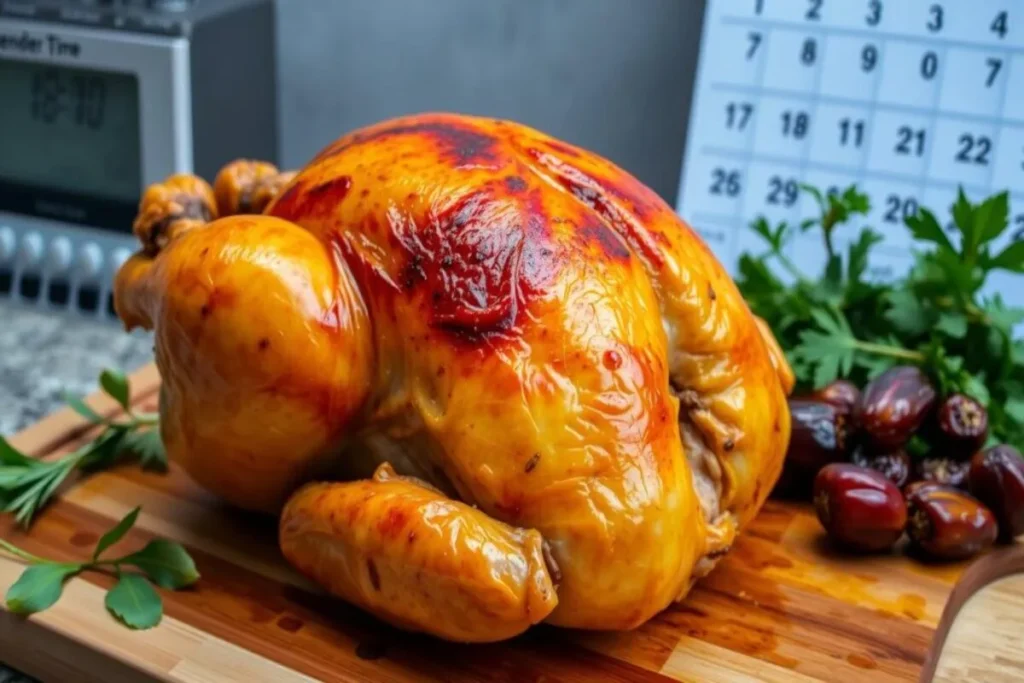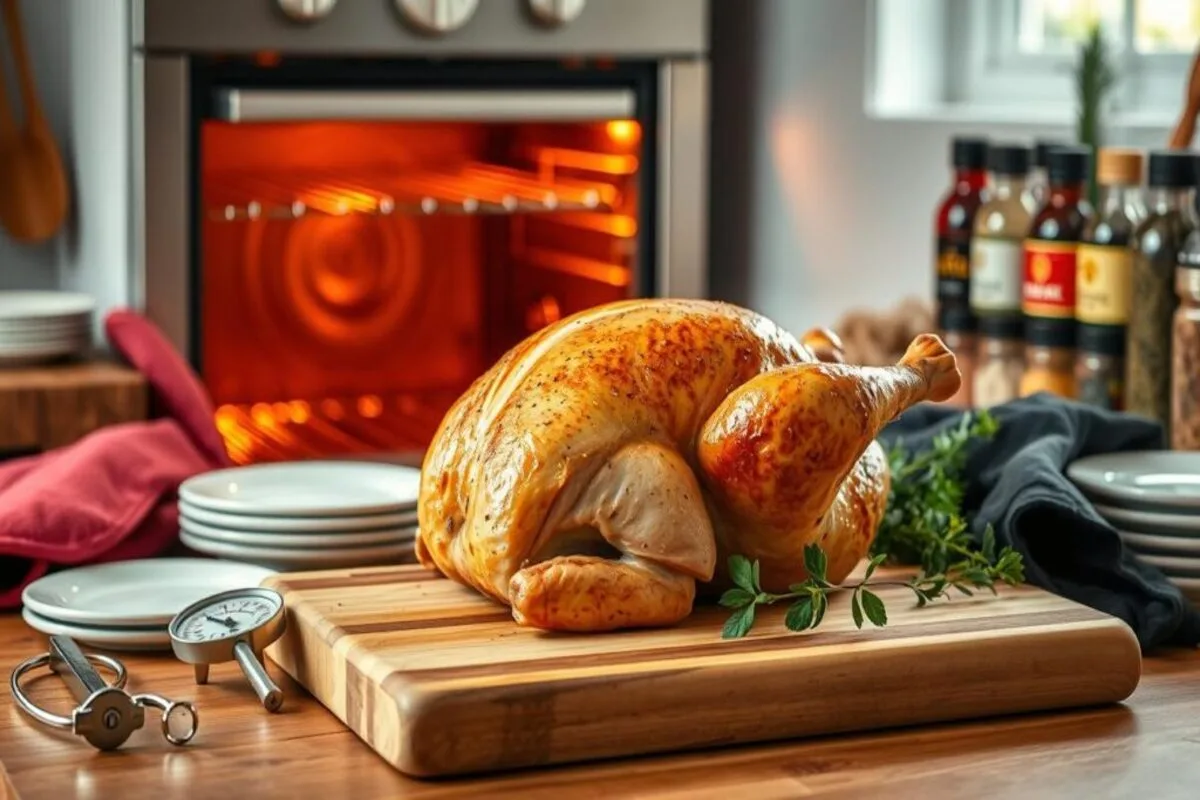Rotisserie chicken is a favorite for many because it’s easy and tasty. But, have you thought about how long it stays good and when it expires? Knowing how long a rotisserie chicken lasts is key to keeping food safe and enjoying your meals.
If you often buy rotisserie chicken, you might want to know how long it keeps. This knowledge helps you plan meals and avoid wasting food. We’ll explore rotisserie chicken’s shelf life, how to store it, and signs of spoilage. This way, you can enjoy your chicken when it’s fresh and safe.
For busy people or parents, knowing about rotisserie chicken storage is important. It helps you enjoy its convenience and taste while keeping food safe and reducing waste.
Understanding Rotisserie Chicken Shelf Life
Storing rotisserie chicken right is key to keeping it fresh. The shelf life depends on storage, handling, and conditions. Keeping it properly stored helps it last longer.
Temperature, handling, and storage conditions all matter. Temperature is critical; keep it in a fridge at 40°F (4°C) or below. Handling safely is also important to avoid contamination.
Factors Affecting Shelf Life
- Temperature: Store the chicken in a refrigerator at a temperature of 40°F (4°C) or below.
- Handling: Handle the chicken safely to prevent contamination.
- Storage conditions: Store the chicken in a covered container and keep it away from strong-smelling foods.
Importance of Proper Storage
Proper storage is essential for a rotisserie chicken’s life. Follow safe storage tips to avoid foodborne illness. Store it in a covered container and keep it refrigerated at 40°F (4°C) or below.
Knowing what affects rotisserie chicken shelf life and storing it right lets you enjoy it longer. This way, you keep it fresh and safe to eat.
How Long Does Rotisserie Chicken Last in the Refrigerator?
It can stay fresh in the fridge for several days if stored right. Knowing how to store it and when to throw it away is key. This ensures you can enjoy your meal safely.
To keep your chicken fresh, store it in a sealed container at 40°F (4°C) or below. This stops bacteria from growing. Also, store it in a covered container, away from strong smells, and eat it within a few days.
Recommended Storage Time
The fridge is best for 3 to 4 days. But, this can change based on how you store it and the chicken’s quality. Always check for spoilage signs before eating, even if it’s within the time frame.
Signs of Spoilage
Look out for an off smell, slimy texture, and mold. If you see these, toss the chicken to avoid getting sick. Storing it right and knowing spoilage signs helps you enjoy your meal and cuts down on waste.
Freezing : Is It an Option?
Freezing is a great way to keep rotisserie chicken fresh. It stops bacteria from growing, keeping your chicken safe and tasty. Just follow some simple storage tips to enjoy your chicken for longer.
First, cool the chicken to room temperature within two hours. This step is key to stopping bacteria. Then, put it in airtight containers or freezer bags. Make sure to squeeze out as much air as you can before sealing.
How to Properly Freeze Chicken
- Use airtight containers or freezer bags to prevent freezer burn and other flavors from affecting the chicken.
- Label the containers or bags with the date and contents, so you can easily keep track of how long it’s been stored.
- Store the chicken at 0°F (-18°C) or below to maintain its quality and safety.
Thawing Tips for Frozen Chicken
When you’re ready to eat your frozen chicken, thaw it safely. You can thaw it in the fridge, in cold water, or in the microwave. Always cook or reheat it to 165°F (74°C) for food safety.
By following these steps, you can enjoy your rotisserie chicken while keeping it fresh and safe. Always remember to store your chicken properly to get the best taste and quality.
Storage Tips for Keeping Fresh
Storing rotisserie chicken right is key to keeping it fresh and safe. You need to follow the best practices to prevent bacteria and keep the chicken good for longer.
It’s important to pay attention to the container and fridge or freezer settings. Use airtight, shallow containers to stop moisture and bacteria growth.
Recommended Containers
- Airtight, shallow containers
- Zip-top plastic bags
- Aluminum foil or plastic wrap for wrapping individual portions
Best Temperature Settings
Store chicken in the refrigerator at 40°F (4°C) or below to maintain freshness. For extended storage, freeze it at 0°F (-18°C) or colder. Following these temperature guidelines ensures safety and preserves quality.
Using airtight containers and proper temperature settings keeps your chicken fresh and safe for longer.
How to Tell if Chicken Has Gone Bad
Recognizing when the shelf life has ended is crucial for avoiding illness. Check for signs of spoilage, such as a slimy texture, mold, or an unusual odor. Conducting a smell and texture test can help determine if it’s safe to eat
Visual Indicators
- Check for mold or slime on the surface of the chicken
- Look for any discoloration or unusual growth
- Check the packaging for any signs of damage or leakage
Smell and Texture Tests
If you smell something off or feel a slimy texture, it’s best to throw it away. Also, if the chicken feels soft or mushy when you cut into it, it’s bad.
By knowing these signs of spoilage, you can enjoy your rotisserie chicken safely. Always put food safety first and handle your chicken carefully to avoid health risks.
Reheating Rotisserie Chicken Safely
Reheating rotisserie chicken safely is key. Knowing how long it stays good is important. Cooked chicken can be reheated safely if stored at 40°F (4°C) or below within two hours.
Use the oven, microwave, or stovetop to reheat. Make sure the chicken heats up to 165°F (74°C) to avoid foodborne illnesses.
Best Methods for Reheating
- Oven: Preheat to 350°F (175°C). Put the chicken in a covered dish. Heat for 20-25 minutes until it reaches 165°F (74°C).
- Microwave: Use a microwave-safe dish. Heat on high for 2-3 minutes until it reaches 165°F (74°C).
- Stovetop: Put the chicken in a pan with a bit of liquid. Heat over medium, stirring often, until it reaches 165°F (74°C).
Desired Internal Temperature
Checking the chicken’s internal temperature is vital. Use a food thermometer in the thickest part of the breast or thigh. If it’s under 165°F (74°C), keep reheating and checking until it’s right.

Meal Prep Ideas with Rotisserie Chicken
It is great for meal prep because it’s so versatile. To keep it fresh, store it in a sealed container in the fridge. This is one of the tips for keeping it fresh.
Here are some meal prep ideas:
- Chicken salad: Shred the chicken and mix it with your favorite greens, vegetables, and dressing.
- Chicken soup: Use the chicken to make a delicious and comforting soup.
- Chicken wraps: Slice the chicken and wrap it in a tortilla with your favorite fillings.
Quick and Easy Recipes
It is perfect for quick and easy recipes. Try making chicken quesadillas, chicken Caesar salad, or chicken and rice bowls.
Creative Use in Leftover Dishes
Be creative with leftover rotisserie chicken. Use it in chicken pot pie, chicken tacos, or chicken and vegetable stir-fry.
Nutritional Benefits
Rotisserie chicken is loved for its tasty flavor and ease of use. It also has many health benefits, making it a smart choice for a balanced diet. A single serving is packed with protein, which is key for muscle health.
Its high protein content is a big plus. This is great for those who work out or want to stay healthy. Plus, rotisserie chicken is rich in vitamins and minerals like niacin, vitamin B6, and selenium.
Protein Content and Health Benefits
A 3-ounce serving of rotisserie chicken has about 25 grams of protein. This makes it a top-notch protein source. It also has only about 4 grams of fat, which is low.
Comparison with Other Chicken Options
Rotisserie chicken beats other chicken types in nutrition. For instance, grilled chicken breast might have less fat but less flavor too. Fried chicken, on the other hand, is too high in fat and calories. So, rotisserie chicken is a healthier pick.
In summary, rotisserie chicken is both nutritious and tasty. It’s high in protein, low in fat, and full of health benefits. It’s perfect for anyone looking for a healthy, easy meal.
The Convenience of Buying
Many people find rotisserie chicken convenient for meal planning. It saves time for those with busy lives. Buying a pre-cooked rotisserie chicken means less time spent on cooking.
Rotisserie chicken is also a budget-friendly choice. It costs less than cooking a whole chicken. Surveys and cost analyses show rotisserie chicken is cheaper.
Time-Saving Benefits
Rotisserie chicken offers several time-saving perks:
- No need to spend time cooking and preparing a whole chicken
- Easy to serve and ready to eat
- Can be used in a variety of dishes, such as salads, sandwiches, and soups
Cost-Effectiveness Compared to Whole Chicken
Rotisserie chicken is also a cost-effective choice. It’s often cheaper than a whole chicken. This makes it a good option for saving money on groceries.

Popular Rotisserie Chicken Brands in the U.S.
In the U.S., many brands are available. Choosing the right one can be tough. Look at quality, price, and what others say to help decide.
Brands like Costco, Walmart, and Whole Foods are well-known. They offer different types. Think about what’s important to you: taste, ease, or cost.
Key Considerations for Brand Selection
- Quality of the chicken: Choose brands that use hormone-free chicken.
- Price: Compare prices to find the best deal.
- Customer reviews: See what others say online.
Researching these factors helps you pick a good rotisserie chicken brand. Always choose quality and safety first. Don’t hesitate to try new brands to find your favorite.
Frequently Asked Questions
Rotisserie chicken is a popular choice, but many have questions. We’ve gathered answers to common FAQs. This will help you understand and enjoy this tasty food.
Some top questions include:
- How long does rotisserie chicken last in the refrigerator?
- Can I freeze it?
- What are the best safe storage practices?
For safe enjoyment, it’s key to follow safe storage practices. Store the chicken in a sealed container at 40°F (4°C) or below. By doing this and knowing the answers to rotisserie chicken FAQs, you can enjoy your chicken safely.
Conclusion:
As we wrap up our look at rotisserie chicken, remember it’s more than just tasty. Keeping food safe is key, and rotisserie chicken is no exception. By following storage tips and watching for signs of spoilage, you can enjoy your chicken safely and hygienically.
Final Tips for Best Enjoyment
To enjoy rotisserie chicken responsibly, keep it at the right temperature and reheat it well. Watch for any signs it might be bad. With a bit of care, your chicken will stay fresh and safe, making every bite enjoyable.
When to Know It’s Time to Toss
If your chicken looks or smells off, it’s time to throw it away. Food poisoning is serious, so trust your instincts. By following these tips, you can enjoy your rotisserie chicken responsibly and enjoy every bite.
FAQ
How long is rotisserie chicken good for in the refrigerator?
Cooked stays good for 3-4 days in the fridge. Make sure it’s in an airtight container or resealable bag.
What are the signs that rotisserie chicken has gone bad?
A bad rotisserie chicken feels slimy, smells off, or looks different from its original color. If it’s been out for over 2 hours, throw it away.
Can I freeze leftover rotisserie chicken?
Yes, you can freeze leftover chicken. Remove the meat, put it in an airtight container or bag, and freeze for 3-4 months. Thaw it in the fridge before reheating.
What’s the best way to reheat ?
Reheat chicken in the oven at 350°F or on the stovetop in a skillet. Make sure it heats to 165°F to be safe to eat.
How can I keep my fresh for longer?
Keep chicken fresh by storing it in an airtight container or bag in the fridge. Don’t leave it out for more than 2 hours. Freeze leftovers you won’t use in 3-4 days.
Is rotisserie chicken healthier than other chicken options?
Rotisserie chicken is healthier than fried or processed chicken. It’s lean protein and good for meals. But, watch the sodium.
What are some popular brands in the U.S.?
Top rotisserie chicken brands in the U.S. include Costco’s Kirkland Signature, Boston Market, Sam’s Club’s Member’s Mark, and Whole Foods’ rotisserie options.

